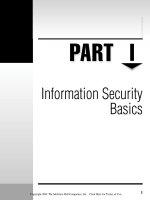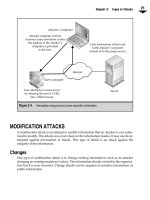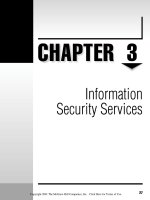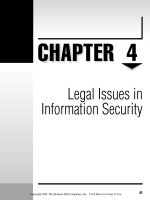Bảo mật hệ thống mạng part 2 ppsx
Bạn đang xem bản rút gọn của tài liệu. Xem và tải ngay bản đầy đủ của tài liệu tại đây (281.51 KB, 9 trang )
10
Network Security: A Beginner’s Guide
products. If the product is not certified, users might be considered negligent if their site
was successfully penetrated. Unfortunately, we have two problems with such a concept:
▼
The pace of technology continues so there is little reason to believe that a lab
would have any better luck certifying products before they become obsolete
than previous attempts.
▲
It is extremely difficult if not impossible to prove that something is secure. You
are in effect asking the lab to prove a negative (that the system cannot be broken
into). What if a new development tomorrow causes all previous certifications to
become obsolete? Does every system now have to be recertified?
As the industry continues to search for the final answer, we are left to define security
as best we can. We do this through good security practice and constant vigilance.
WHY SECURITY IS A PROCESS, NOT POINT PRODUCTS
Obviously, we cannot just rely on a single type of security to provide protection to an orga-
nization’s information. Likewise, we cannot rely on a single product to provide all of the
necessary security for our computer and network systems. Unfortunately, some vendors
(in their zeal to sell their products) have implied that such was actually true. The reality of
the situation is that no one product will provide total security for an organization. Many
different products and types of products are necessary to fully protect an organization’s in-
formation assets. In the next few paragraphs, we will see why some of the more prominent
security product categories cannot be the all-encompassing solution.
Anti-Virus Software
Anti-virus software is a necessary part of a good security program. If properly imple
-
mented and configured, it can reduce an organization’s exposure to malicious programs.
However, anti-virus software only protects an organization from malicious programs
(and not all of them—remember Melissa?). It will not protect an organization from an in
-
truder who misuses a legitimate program to gain access to a system. Nor will anti-virus
software protect an organization from a legitimate user who attempts to gain access to
files that he should not have access to.
Access Controls
Each and every computer system within an organization should have the capability to re
-
strict access to files based on the ID of the user attempting the access. If systems are prop
-
erly configured and the file permissions set appropriately, file access controls can restrict
legitimate users from accessing files they should not have access to. File access controls
will not prevent someone from using a system vulnerability to gain access to the system
TEAMFLY
Team-Fly
®
Chapter 1: What Is Information Security?
11
as an administrator and thus see files on the system. Even access control systems that al
-
low the configuration of access controls on systems across the organization cannot do
this. To the access control system, such an attack will look like a legitimate administrator
attempting to access files to which the account is allowed access.
Firewalls
Firewalls are access control devices for the network and can assist in protecting an orga
-
nization’s internal network from external attacks. By their nature, firewalls are border se
-
curity products, meaning that they exist on the border between the internal network and
the external network. Properly configured, firewalls have become a necessary security
device. However, a firewall will not prevent an attacker from using an allowed connec
-
tion to attack a system. For example, if a Web server is allowed to be accessed from the
outside and is vulnerable to an attack against the Web server software, a firewall will
likely allow this attack since the Web server should receive Web connections. Firewalls
will also not protect an organization from an internal user since that internal user is al
-
ready on the internal network.
Smart Cards
Authenticating an individual can be accomplished by using any combination of some-
thing you know, something you have, or something you are. Historically, passwords
(something you know) have been used to prove the identify of an individual to a com-
puter system. Over time, we have found out that relying on something you know is not
the best way to authenticate an individual. Passwords can be guessed or the person may
write it down and the password becomes known to others. To alleviate this problem, secu-
rity has moved to the other authentication methods—something you have or something
you are.
Smart cards can be used for authentication (they are something you have) and thus
can reduce the risk of someone guessing a password. However, if a smart card is stolen
and if it is the sole form of authentication, the thief could masquerade as a legitimate user
of the network or computer system. An attack against a vulnerable system will not be pre
-
vented with smart cards as a smart card system relies on the user actually using the cor
-
rect entry path into the system.
Biometrics
Biometrics are yet another authentication mechanism (something you are) and thus they
too can reduce the risk of someone guessing a password. As with other strong authentica
-
tion methods, for biometrics to be effective, access to a system must be attempted through
a correct entry path. If an attacker can find a way to circumvent the biometric system,
there is no way for the biometric system to assist in the security of the system.
Intrusion Detection
Intrusion detection systems were once touted as the solution to the entire security prob
-
lem. No longer would we need to protect our files and systems, we could just identify
when someone was doing something wrong and stop them. In fact, some of the intrusion
detection systems were marketed with the ability to stop attacks before they were suc
-
cessful. No intrusion detection system is foolproof and thus they cannot replace a good
security program or good security practice. They will also not detect legitimate users who
may have incorrect access to information.
Policy Management
Policies and procedures are important components of a good security program and the
management of policies across computer systems is equally important. With a policy man
-
agement system, an organization can be made aware of any system that does not conform
to policy. However, policy management may not take into account vulnerabilities in sys
-
tems or misconfigurations in application software. Either of these may lead to a successful
penetration. Policy management on computer systems also does not guarantee that users
will not write down their passwords or give their passwords to unauthorized individuals.
Vulnerability Scanning
Scanning computer systems for vulnerabilities is an important part of a good security
program. Such scanning will help an organization to identify potential entry points for
intruders. In and of itself, however, vulnerability scanning will not protect your com-
puter systems. Each vulnerability must be fixed after it is identified. Vulnerability scan-
ning will not detect legitimate users who may have inappropriate access nor will it detect
an intruder who is already in your systems.
Encryption
Encryption is the primary mechanism for communications security. It will certainly protect
information in transit. Encryption might even protect information that is in storage by en
-
crypting files. However, legitimate users must have access to these files. The encryption
system will not differentiate between legitimate and illegitimate users if both present the
same keys to the encryption algorithm. Therefore, encryption by itself will not provide
security. There must also be controls on the encryption keys and the system as a whole.
Physical Security Mechanisms
Physical security is the one product category that could provide complete protection to
computer systems and information. It could actually be done relatively cheaply as well.
Just dig a hole about 30 feet deep. Line the hole with concrete and place all-important sys
-
tems and information in the hole. Then fill up the hole with concrete. Your systems and
information will be secure. No one will be able to access them. Unfortunately, this is not a
12
Network Security: A Beginner’s Guide
reasonable solution to the security problem. Employees must have access to computers
and information in order for the organization to function. Therefore, the physical security
mechanisms that we put in place must allow some people to gain access and the com
-
puter systems will probably end up on a network. If this is the case, physical security will
not protect the systems from attacks that use legitimate access or attacks that come across
the network instead of through the front door.
Chapter 1: What Is Information Security?
13
This page intentionally left blank.
CHAPTER
2
Types of Attacks
15
Copyright 2001 The McGraw-Hill Companies, Inc. Click Here for Terms of Use.
B
ad things can happen to an organization’s information or computer systems in
many ways. Some of these bad things are done on purpose (maliciously) and others
occur by accident. No matter why the event occurs, damage is done to the organiza
-
tion. Because of this, we will call all of these events “attacks” regardless of whether there
was malicious intent or not.
There are four primary categories of attacks:
▼
Access
■
Modification
■
Denial of service
▲
Repudiation
We will cover each of these in detail in the following sections.
Attacks may occur through technical means (a vulnerability in a computer system) or
they may occur through social engineering. Social engineering is simply the use of
non-technical means to gain unauthorized access—for example, making phone calls or
walking into a facility and pretending to be an employee. Social engineering attacks may
be the most devastating.
Attacks against information in electronic form have another interesting characteristic:
information can be copied but it is normally not stolen. In other words, an attacker may
gain access to information, but the original owner of that information has not lost it. It just
now resides in both the original owner’s and the attacker’s hands. This is not to say that
damage is not done; however, it may be much harder to detect since the original owner is
not deprived of the information.
ACCESS ATTACKS
An access attack is an attempt to gain information that the attacker is unauthorized to see.
This attack can occur wherever the information resides or may exist during transmission
(see Figure 2-1). This type of attack is an attack against the confidentiality of the information.
Snooping
Snooping is looking through information files in the hopes of finding something interest
-
ing. If the files are on paper, an attacker may do this by opening a filing cabinet or file
drawer and searching through files. If the files are on a computer system, an attacker may
attempt to open one file after another until information is found.
Eavesdropping
When someone listens in on a conversation that they are not a part of, that is eavesdrop
-
ping. To gain unauthorized access to information, an attacker must position himself at a
16
Network Security: A Beginner’s Guide
location where information of interest is likely to pass by. This is most often done elec
-
tronically (see Figure 2-2).
Interception
Unlike eavesdropping, interception is an active attack against the information. When an
attacker intercepts information, she is inserting herself in the path of the information and
capturing it before it reaches its destination. After examining the information, the at
-
tacker may allow the information to continue to its destination or not (see Figure 2-3).
Chapter 2: Types of Attacks
17
Communications tower
Information in transit
over the Internet or
phone lines
Desktop computer
Fax
City
Information coming
off fax machines or
printers
Information on
local hard drives
Information on
file servers
Information stored on
media and left in the
office or on backups
taken off-site
Information on
paper in the office
Mainframe
Figure 2-1.
Places where access attacks can occur
18
Network Security: A Beginner’s Guide
How Access Attacks Are Accomplished
Access attacks take different forms depending on whether the information is stored on
paper or electronically in a computer system.
Information on Paper
If the information the attacker wishes to access exists in physical form on paper, he needs
to gain access to the paper. Paper records and information are likely to be found in the fol
-
lowing locations:
▼
In filing cabinets
■
In desk file drawers
■
On desktops
■
In fax machines
■
In printers
■
In the trash
▲
In long term storage
In order to snoop around the locations, the attacker needs physical access to them. If he’s
an employee, he may have access to rooms or offices that hold filing cabinets. Desk file draw
-
Figure 2-2.
Eavesdropping









